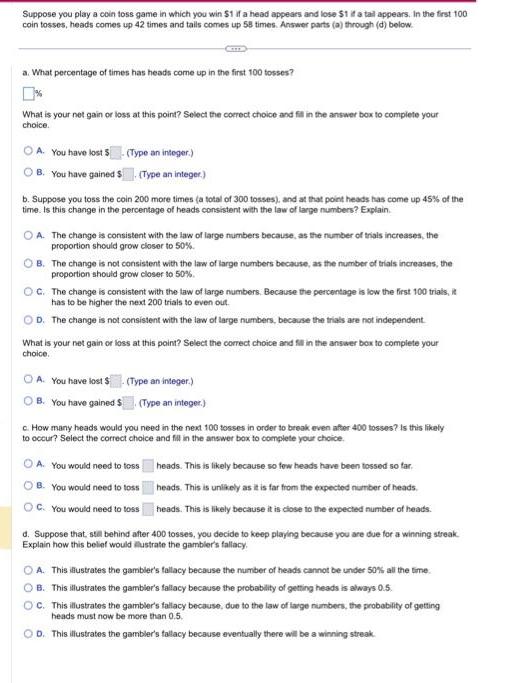Answered step by step
Verified Expert Solution
Question
1 Approved Answer
Suppose you play a coin toss game in which you win $1 if a head appears and lose $1 if a tail appears. In

Suppose you play a coin toss game in which you win $1 if a head appears and lose $1 if a tail appears. In the first 100 coin tosses, heads comes up 42 times and tails comes up 58 times. Answer parts (a) through (d) below. a. What percentage of times has heads come up in the first 100 tosses? What is your net gain or loss at this point? Select the correct choice and fill in the answer box to complete your choice. OA. You have lost 5 (Type an integer.) B. You have gained $. (Type an integer) b. Suppose you toss the coin 200 more times (a total of 300 tosses), and at that point heads has come up 45% of the time. Is this change in the percentage of heads consistent with the law of large numbers? Explain OA. The change is consistent with the law of large numbers because, as the number of trials increases, the proportion should grow closer to 50%. B. The change is not consistent with the law of large numbers because, as the number of trials increases, the proportion should grow closer to 50%. OC. The change is consistent with the law of large numbers. Because the percentage is low the first 100 trials, it has to be higher the next 200 trials to even out. D. The change is not consistent with the law of large numbers, because the trials are not independent. What is your net gain or loss at this point? Select the correct choice and fill in the answer box to complete your choice. A. You have lost $(Type an integer.) B. You have gained $ (Type an integer.) c. How many heads would you need in the next 100 tosses in order to break even after 400 tosses? Is this likely to occur? Select the correct choice and fill in the answer box to complete your choice. A. You would need to toss B. You would need to toss OC. You would need to toss heads. This is likely because so few heads have been tossed so far. heads. This is unlikely as it is far from the expected number of heads. heads. This is likely because it is close to the expected number of heads. d. Suppose that, still behind after 400 tosses, you decide to keep playing because you are due for a winning streak Explain how this belief would illustrate the gambler's fallacy A. This illustrates the gambler's fallacy because the number of heads cannot be under 50% all the time. B. This illustrates the gambler's fallacy because the probability of getting heads is always 0.5 C. This illustrates the gambler's fallacy because, due to the law of large numbers, the probability of getting heads must now be more than 0.5. OD. This illustrates the gambler's fallacy because eventually there will be a winning streak
Step by Step Solution
★★★★★
3.59 Rating (167 Votes )
There are 3 Steps involved in it
Step: 1
A 42 and You have lost 16 B The change is consistent with the law of large numbers because as the number of trials increases the proportion should gro...
Get Instant Access to Expert-Tailored Solutions
See step-by-step solutions with expert insights and AI powered tools for academic success
Step: 2

Step: 3

Ace Your Homework with AI
Get the answers you need in no time with our AI-driven, step-by-step assistance
Get Started


